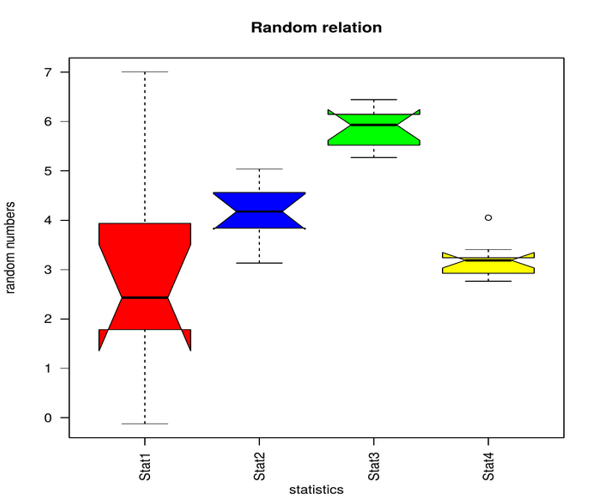

UniDistExampleData=c(runif(1000, min = min(distExampleData), max = max(distExampleData)) )īoxplot(uniDistExampleData, horizontal=TRUE, ylim=c(-10,20), xaxt="n", col=primar圜olor, frame=F) The following plot shows a very similar box plot but with an entirely different distribution. Hist(distExampleData, breaks=40, col=secondar圜olor, border=F, main="", xlab="value of the variable", xlim=c(-10,20)) Layout(mat = matrix(c(1,2),2,1, byrow=TRUE), height = c(1,8))īoxplot(distExampleData, horizontal=TRUE, ylim=c(-10,20), xaxt="n", col=primar圜olor, frame=F) For example, if we were looking at just the box plot of the following data set, we wouldn’t be able to tell if the distribution of the data is centered about two points or pretty much spread even across the data range. Hist(dataLogNorm, col = primar圜olor, breaks = 50)īoxplot(dataLogNorm, horizontal=TRUE, col = secondar圜olor, outline=TRUE, add = TRUE)īox plots do not display all statistics needed to determine the distribution. The following plot shows a histogram and a boxplot of the same data to help understand the box plot and how the data is divided into quartiles. Names(combinedData) = c("Normal Dist", "Log Normal Dist")īoxplot(combinedData, col = c(primar圜olor, secondar圜olor) ) combinedData = list(dataNorm, dataLogNorm) The first and second quartiles are very short compared to the first and second quartiles of the normal distribution example, and compared to the third and fourth quartile of the log normal distribution. The plots show that the distribution between the data points is different. The following plot shows a boxplot of data with a normal distribution and a box plot of data with a log normal distribution. Names(C)=c(paste("Category 1\n n=", length(cat1), sep=""), paste("Category 2\n n=", length(cat2), sep=""))īoxplot(C, col=c(primar圜olor, secondar圜olor), ylab="value" ) Having the two plots side by side helps make a quick comparison to see if the numeric data in one category is significantly different than in the other category. The plot shows two box plots, one for category 1 and the other for category 2. The box plot is also useful for evaluating the relationship between numeric data (continuous data) and categorical data (finite data).

For example, 100 or more data points with a normal distribution commonly have some outliers. With large data points, outliers are usually expected. With a loose definition of outliers, you could use the chart to identify the possible existence of outliers. The interpretation of the compactness or spread of the data also applies to each of the 4 sections of the box plot. If the box plot is relatively tall, then the data is spread out. IF the box plot is relatively short, then the data is more compact. They have the general form: The middle part of the diagram is called the Box, with the horizontal lines and end points at each side referred to as the whiskers. A box plot gives us a basic idea of the distribution of the data. A list of values with quartiles can be illustrated with what is known as a Box and Whisker Plot, sometimes referred to as just a Box Plot.


 0 kommentar(er)
0 kommentar(er)
